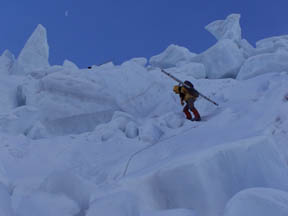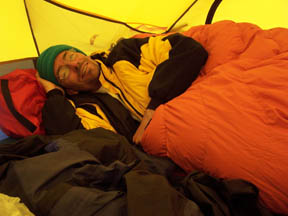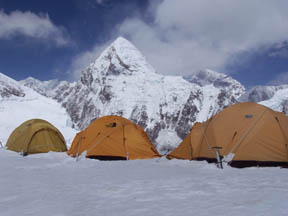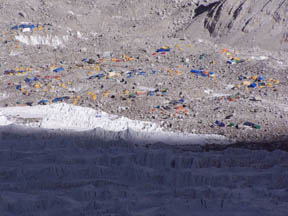|
Now that Tom has had a few days to acclimate at base camp and do some day hikes part way up the slopes of a beautiful neighboring peak, Pumori, he is ready to get to know Everest. During these days, our climbing Sherpas--Nima Tashi , Nima Gombu, and Pem Dorjee--have started carrying up tents, sleeping bags, stoves, food, and other equipment needed to establish the team at Camps I and II. Tom also wants to help carry some equipment, but needs to first get experience going through the treacherous Icefall and accclimatizing to the altitude of the camps beyond, in the wide, gently-sloping valley called the Western Cwm ("cwm", pronounced "koom" is Welsh for "valley"). Although the summit of Mt. Everest is not visible from base camp, the huge and deadly Khumbu Icefall dramatically dominates the scene. As a waterfall would cascade chaotically down a precipice, so too does the glacial ice at this steep part of the mountain (only much slower than water of course). As it creeps off the flatter Western Cwm, the glacial sheet fractures and tumbles down the Icefall. The result is a vast maze of soaring ice towers and deep crevasses. Each year a special team of Sherpas, collectively called "The Icefall Doctors" establishes a relatively safe route through the Icefall, using dozens of aluminum ladders and miles of ropes. Each expedition team that uses this route is then assessed a one-time flat fee for the season by the "Doctors". This is acknowledged to be the cheapest, most efficient, and safest way to get teams quickly through that dangerous part of the climb. Tom and Nawang will begin climbing together now, going to one of the camps, coming back to base camp, then going back up a following day, this time sleeping at the camp one or two nights, then coming back down. Though this is slow and tedious, it builds endurance, acclimatization levels, and knowledge of how to navigate quickly through the dangers of the Icefall. Camp I sits at the top of the Icefall at about 19,500ft. on the edge of the Western Cwm. It has great views of base camp and is situated on fairly level snow.
|
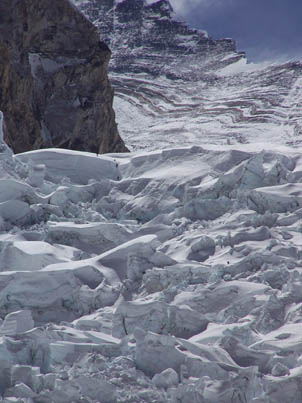 Climbers ascend the final ladders on the headwall
of the Khumbu Icefall (small black dots below the prominent rock shoulder,
upper left)
Climbers ascend the final ladders on the headwall
of the Khumbu Icefall (small black dots below the prominent rock shoulder,
upper left)
